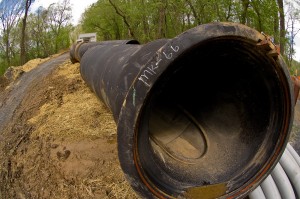Case load brings recognition to EPA lawyer
By Amy Miller
Attorney Jeff Kopf was called to the deputy administrator’s office to talk about cases he had settled with towns or companies who had violated environmental laws. Getting called to the boss’s office is not an every day occurrence for a lawyer in EPA New England’s office, so he wondered why these cases were drawing attention.
When he arrived at Deb Szaro’s office, Jeff found, rather than a discussion of legal matters, a group of colleagues there to congratulate him. Jeff, now in his 19th year at EPA New England, was being recognized as “Employee of the Month” for his work in settling five separate cases that will ensure cleaner water for communities around New England.
Every month EPA recognizes an employee whose work has made a significant contribution to public health or environmental protection and most recently it was Jeff.
A native of Brookline now living in Newton, Jeff, generally handles cases involving the Clean Water Act. This focus on water is a natural outgrowth of his initial interest in environmental work.
Before joining EPA, he worked at a wildlife rehab center near Seattle, Wash. There he washed sea birds covered in oil from a large oil spill off the coast. He also learned skills related to capturing and caring for injured urban wildlife such as raccoons, opossums and seagulls, and he learned how to track released animals with radio tracking devices, including eagles, black bears and coyotes. Then he went to Boston College Law School with a focus on environmental law.
“I like working with communities to solve big waste water and stormwater infrastructure problems to come up with a solution,” said Jeff, a Brookline native now living in Newton. “I always like those cases that prevent oil spills from getting into the environment.”
In addition to the five enforcement actions Jeff finished under the Clean Water Act, he also oversaw the completion of a sixth case by an honors fellow he mentors. And besides the impressive number of cases he handled in just one recent month, Jeff was lead attorney for a total of 19 Clean Water Act cases finished in the fiscal year (which ended Sept. 30.)
“This incredible level of productivity, and the direct environmental results that he achieved in August alone, deserved recognition,” said Deputy Regional Administrator Deb Szaro
Four of the cases closed recently by Jeff – in Worcester and Halifax, Mass., and in Derby and Bridgeport, Conn., – were with municipalities. Two others – Foster Materials in Henniker, N.H., and Townsend Oil in Georgetown, Mass. – involved companies. The cases for the most part included violations involving illicit discharges, for instance an industry not fully complying with its stormwater permit, not using best management practices or not following spill prevention rules.
The cases include actions in: Worcester, which will address unauthorized discharges to Lake Quinsigamond and the Blackstone River by putting in place a plan to manage stormwater; Bridgeport, Conn., which discharged untreated sewage to the Bridgeport Harbor and Pequannock River, will address sewer overflows; Halifax, which agreed to address violations of its discharge permit at the town’s water treatment plant; Derby, Conn., which has discharged untreated sewage into the Naugatuck and Housatonic Rivers, and will put in place a program to address ongoing sewer overflows; Foster Materials, which has a sand and gravel mine and production facility in Henniker, NH, and pay a $20,000 fine for discharging sediment-laden water into the Contoocook River; and Townsend Oil, which operates a fuel oil bulk plant in Georgetown,., and to pay $30,000 to settle claims it failed to maintain and fully put in place a spill prevention plan.
Jeff acknowledged it is “certainly nice to be recognized,” but noted that enforcement cases involve collaboration, an aspect of his job he particularly values.
“Part of what I enjoy here,” he said, “is working with the technical staff the engineers who helped me put those cases together and helped in settling them.”
More information on how EPA enforces the Clean Water Act (https://www.epa.gov/enforcement/water-enforcement) and how EPA works with companies to avoid oil spills from occurring (https://www.epa.gov/oil-spills-prevention-and-preparedness-regulations)
Amy Miller works in the office of public affairs at EPA New England.





